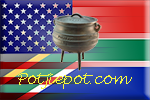Potjie Pot History
The Potjie Pot
Pronounced “poi-key” (pot) and “poi-key-cos” (pot food). The potjie is the pot and the latter is the traditional way of cooking that dates back to the 1500's.
The potjie pot however dates back to the iron age when man learned to cast iron into vessels of different shapes for a variety of purposes. The pots during this time also developed a lot of mystery due to the fact that they were very popular amongst the witches and druids of the time, who used the pots for their rituals and ceremonies.
The potjies also bring to mind cannibals and the name “missionary pots”, which they are often called. It was during this era that the round belly three legged cooking pot developed and for all practical intents and purposes, became an ideal cooking pot that was designed to be used over an open fire.
In the mid 1600's the potjie and the traditional way of cooking arrived in Africa, along with the early explorers, who used these cooking vessels exclusively, on their expeditions into the interior. It was during this period that the tribal Africans saw these pots and seeing the practical uses, traded these pots for animal hides and other commodities, replacing clay pots that were used for cooking.
Among the African tribal cultures these pots became known as “Putu” pots (corn meal pots). As a result, the potjie is used extensively in Africa today by almost all cultures, and has survived the test of time.
Over the centuries, the potjie has retained most of its original shape and traditional form because of the age-old practical features. With modern technology it is possible to produce today, this high quality cast iron cookware, that has become as popular as it was then, an essential cooking utensil.
Potjiekos has its origins dating back to the war between the Netherlands and Spain (1566-1648). It was during this time that the siege of Leyden took place and food was very scarce, that the towns people were forced to eat “hutspot” (hodgepodge) to survive. The town’s people all contributed what meager morsels they had at home, into a large communal pot and cooked it all together. Today in Holland, hutspot is still cooked at the annual commemoration day, of the “Siege of Leyden”.
It was the Dutch who then took this way of cooking to Africa, when the colonial administrator Jan Van Riebeeck set sail and landed at the “Cape of Good Hope” in 1652. Not only did these early settlers use the potjies for potjiekos, but also for baking breads using the potjies as an oven and always over an open fire. When trade to Africa increased, mainly by the Dutch East India Company, many new spices and herbs became available that further contributed to the evolution of potjiekos and has become a unique cuisine on its own.
Potjiekos is robust, full of flavours, very healthy, but it is also a friendly and very sociable occasion. Not only is potjiekos healthy food, but it is also healthy in that it causes one to relax, be happy and enjoy good company. Potjiekos is an experience all on its own!! - Potjiekos is really a group of good friends, a well seasoned potjie, good beer or a fine wine, a warm fire, lots of time, fine food, tall stories and delectable aromas.
The pores in the cast iron capture flavours of past potjiekos, which gradually get released into the potjie as the metal heats up. Most potjiekos taste better the next day after having “aged” overnight in the pot.
For some interresting Potjie recipes please visit http://www.potjiekosworld.com/
There are no products to list in this category.
